Altamura and the meaning of claustrophobia
Take a walk around Altamura in Puglia behind the city walls and you will find a town closing in on itself. Then you will know more about Altamura and the meaning of claustrophobia.
Booking.com
We have been in Altamura between Bari in Puglia and Matera in Basilicata several times, but I would not have noticed one of the most unique features without the guidance of Tonio Creanza. He started a walk around Altamura by producing a street map and calling attention to the neat division of the inner walled city in four equal sized parts.
Segregation
The two main roads going north-south and east-west divide the old town into sections that segregated the Muslims from the Jews from the Greeks and the Latins. Who belongs where should still be visible in the street names, though that particular detail is beyond me.

Stairs leading over the town walls. The central square where the two main roads cross. And an attempt to capture the cramped architecture.
Constricted Spaces
The lacking will to mingle with other religious and ethnic group soon became a designing feature. With very thick, high and necessary city walls space was constricted, but to begin with all families had a house and a yard. The problems arose as the children in these families grew up and wanted to settle down and start their own family.
Then the family property was divided into ever decreasing lots and after a few generation space became so cramped, it was impossible to squeeze in another house.
Obviously Claustrophobic
The remaining open square leading to the houses is called a ‘claustro’, and going there the reference to claustrophobia is self-explanatory. Some of the 80 odd claustri are not much bigger than a living room and filled with chairs and flowers and shouting and washing and outdoor shoes.
If it is a Greek claustro, there is a tree in the middle, while Muslim claustri are lost in a labyrinth of alleys. In places like this ‘love thy neighbour’ is an obligation. Yet people in the old Altamura did not stretch their definition of neighbours too far. All claustri have only one entrance making it easier to bar the way for enemies and defend the family property.
Other notes like Altamura and the meaning of claustrophobia
Leave a Reply
Want to join the discussion?Feel free to contribute!
Leave a Reply Cancel reply
This site uses Akismet to reduce spam. Learn how your comment data is processed.




Wow..that is some very close quarters. I guess you have to learn to really like and live with your family to make this work. What an interesting history of this part of the city. You never fail to provide such great information on the hidden parts of Italy, Mette.
Yes, you should really appreciate you in-laws in order to live that way. Still, it’s better than sharing house, I guess.
Interesting…
Thank you:)
Mette, I LOVE your posts – the lessons I learn are wonderful. I had no idea this town existed, knew nothing about the segregation nor the claustri.
Thanks so much for broadening my knowledge.
Thanks. And if it is any comfort I’ sure there are a few towns with 70.000 souls in Texas and New Jersey or wherever, I haven’t heard about either:)
Very interesting about the origins of the word: claustrophobic. Must have been quite claustrophobic as children started having grandchildren, who started having great grandchildren…
I guess that’s why they had to give up the system in the end, and start building outside the town walls.
Very interesting article. I shudder to think – with only one entrance/exit, what would happen if a fire started…
Yes. Fortunately most houses in Puglia are built of stone, and they must have found the risk the lesser evil compared to bandits and robbers.
I guess I couldn’t have lived in this town — a little too claustrophobic for me. Very interesting town and one I hope to visit next time in Puglia.
I’m sure yo’ll like it.
What an intriguing history! It’s hard to imagines so many people living in such close quarters while trying to remain segregated. The structures look beautiful though the logic behind the city’s planning is so unfortunate.
Yes, they have been willing to go to extremes in order not to get mixed up with other religious groups.